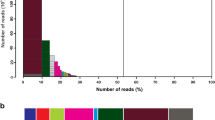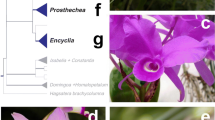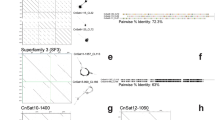Abstract
Main conclusion
We demonstrated by cytogenomic analysis that the proximal heterochromatin of the Northeast Brazilian species of Caesalpinia group is enriched with phylogenetically conserved Ty3/Gypsy-Tekay RT, but diverge in the presence of Ty3/Gypsy-Athila RT and satDNA.
Abstract
The Caesalpinia Group includes 225 species and 27 monophyletic genera of which four occur in Northeastern Brazil: Erythrostemon (1 sp.), Cenostigma (7 spp.), Libidibia (1 sp.), and Paubrasilia (1 sp.). The last three genera are placed in different clades in the Caesalpinia Group phylogeny, and yet they are characterized by having a numerically stable karyotype 2n = 24 (16 M+8A) and GC-rich heterochromatic bands (chromomycin A3 positive/CMA+ bands) in the proximal chromosome regions. To characterize the composition of their heterochromatin and test for the homology of these chromosomal regions, genomic DNA was extracted from Cenostigma microphyllum, Libidibia ferrea, and Paubrasilia echinata, and sequenced at low coverage using the Illumina platform. The genomic repetitive fractions were characterized using a Galaxy/RepeatExplorer-Elixir platform. The most abundant elements of each genome were chromosomally located by fluorescent in situ hybridization (FISH) and compared to the CMA+ heterochromatin distribution. The repetitive fraction of the genomes of C. microphyllum, L. ferrea, and P. echinata were estimated to be 41.70%, 38.44%, and 72.51%, respectively. Ty3/Gypsy retrotransposons (RT), specifically the Tekay lineage, were the most abundant repeats in each of the three genomes. FISH mapping revealed species-specific patterns for the Tekay elements in the proximal regions of the chromosomes, co-localized with CMA+ bands. Other species-specific patterns were observed, e.g., for the Ty3/Gypsy RT Athila elements which were found in all the proximal heterochromatin of L. ferrea or restricted to the acrocentric chromosomes of C. microphyllum. This Athila labeling co-localized with satellite DNAs (satDNAs). Although the Caesalpinia Group diverged around 55 Mya, our results suggest an ancestral colonization of Tekay RT in the proximal heterochromatin. Thus, the present-day composition of the pericentromeric heterochromatin in these Northeast Brazilian species is a combination of the maintenance of an ancestral Tekay distribution with a species-specific accumulation of other repeats.






Similar content being viewed by others
Abbreviations
- CMA:
-
Chromomicin A3
- DAPI:
-
4′,6-diamidino-2-phenylindole
- FISH:
-
Fluorescent in situ hybridization
- LTR:
-
Long-terminal repeat
- RT:
-
Retrotransposons
- satDNA:
-
Satellite DNA
- TEs:
-
Transposable elements
References
Acosta MC, Moscone EA, Cocucci AA (2016) Using chromosomal data in the phylogenetic and molecular dating framework: karyotype evolution and diversification in Nierembergia (Solanaceae) influenced by historical changes in sea level. Plant Biol 18:514–526
Bae YA, Moon SY, Kong Y, Cho SY, Rhyu MG (2001) CsRn1, a novel active retrotransposon in a parasitic trematode, Clonorchis sinensis, discloses a new phylogenetic clade of Ty3/gypsy-like LTR retrotransposons. Mol Biol Evol 18:1474–1483
Barros e Silva AE, Guerra M (2010) The meaning of DAPI bands observed after C-banding and FISH procedures. Biotech Histochem 85:115–125
Bilinski P, Albert PS, Berg JJ, Birchler JA, Grote MN, Lorant A, Quezada J, Swarts K, Yang J, Ross-Ibarra J (2018) Parallel altitudinal clines reveal trends in adaptive evolution of genome size in Zea mays. PLoS Genet 14(5):e1007162
Chalup L, Samoluk SS, Neffa VS, Seijo G (2015) Karyotype characterization and evolution in South American species of Lathyrus (Notolathyrus, Leguminosae) evidenced by heterochromatin and rDNA mapping. J Plant Res 128:893–908
Chiarini FE, Santiñaque FF, Urdampilleta JD, Las Peñas ML (2014) Genome size and karyotype diversity in Solanum sect. Acanthophora (Solanaceae). Plant Syst Evol 300:113–125
De Castro Nunes R, Orozco-Arias S, Crouzillat D, Mueller LA, Strickler SR, Descombes P, Fournier C, Moine D, Kochko A, Yuyama PM, Vanzela ALL, Guyot R (2018) Structure and distribution of centromeric retrotransposons at diploid and allotetraploid Coffea centromeric and pericentromeric regions. Front Plant Sci 9:175
Eickbush TH, Jamburuthugoda VK (2008) The diversity of retrotransposons and the properties of their reverse transcriptases. Virus Res 134:221–234
Emadzade K, Jang TS, Macas J, Kovařík A, Novák P, Parker J, Weiss-Schneeweiss H (2014) Differential amplification of satellite PaB6 in chromosomally hypervariable Prospero autumnale complex (Hyacinthaceae). Ann Bot 114(8):1597–1608
Fischle W, Wang Y, Jacobs SA, Kim Y, Allis CD, Khorasanizadeh S (2003) Molecular basis for the discrimination of repressive methyl-lysine marks in histone H3 by Polycomb and HP1 chromodomains. Gene Dev 17:1870–1881
Gagnon E, Bruneau A, Hughes CE, De Queiroz LP, Lewis GP (2016) A new generic system for the pantropical group (Leguminosae). Phytokeys 71:1–160
Gagnon E, Ringelberg JJ, Bruneau A, Lewis GP, Hughes CE (2019) Global succulent biome phylogenetic conservatism across the pantropical Caesalpinia Group (Leguminosae). New Phytol 222(4):1994–2008
Gao X, Hou Y, Ebina H, Levin HL, Voytas DF (2008) Chromodomains direct integration of retrotransposons to heterochromatin. Genome Res 18:359–369
Garrido-Ramos MA (2015) Satellite DNA in plants: more than just rubbish. Cytogenet Genome Res 146(2):153–170
González ML, Chiapella JO, Urdampilleta JD (2018) Characterization of some satellite DNA families in Deschampsia antarctica (Poaceae). Polar Biol 41(3):457–468
Hartley G, O’Neill RJ (2019) Centromere repeats: hidden gems of the genome. Genes 10(3):223
Hřibová E, Neumann P, Matsumoto T, Roux N, Macas J, Doležel J (2010) Repetitive part of the banana (Musa acuminata) genome investigated by low-depth 454 sequencing. BMC Plant Biol 10:204
Jacobs SA, Khorasanizadeh S (2002) Structure of HP1 chromodomain bound to a lysine 9-methylated histone H3 tail. Science 295:2080–2083
Kejnovsky E, Hawkins JS, Feschotte C (2012) Plant transposable elements: biology and evolution. In: Wendel JF, Greilhuber J, Doležel J, Leitch IJ (eds) Plant genome diversity, vol 1. Plant genomes, their residents and their evolutionary dynamics. Springer-Verlag, Wien, pp 17–34
Kelly LJ, Renny-Byfield S, Pellicer J, Macas J, Novák P, Neumann P, Lysak MA, Day PD, Berger M, Fay MF, Nichols RA, Leitch AR, Leitch IJ (2015) Analysis of the giant genomes of F ritillaria (L iliaceae) indicates that a lack of DNA removal characterizes extreme expansions in genome size. New Phytol 208:596–607
Lanciano S, Mirouze M (2018) Transposable elements: all mobile, all different, some stress responsive, some adaptive? Curr Opin Genet Dev 49:106–114
Lee Y-I, Yap JW, Izan S, Leitch IJ, Fay MF, Lee Y-C, Hidalgo O, Dodsworth S, Smulders MJM, Gravendeel B, Leitch A (2018) Satellite DNA in Paphiopedilum subgenus Parvisepalum as revealed by high-throughput sequencing and fluorescent in situ hybridization. BMC Genomics 19(1):578
Lim KB, De Jong H, Yang TJ, Park JY, Kwon SJ, Kim JS, Lim MH, Kim JA, Jin M, Jin YM, Kim SH, Lim YP, Bang JW, Kim HI, Park BS (2005) Characterization of rDNAs and tandem repeats in the heterochromatin of Brassica rapa. Mol Cells 19(3):436–444
Lin CH, Li B, Swanson S, Zhang Y, Florens L, Washburn MP, Abmayr SM, Workman JL (2008) Heterochromatin protein 1a stimulates histone H3 lysine 36 demethylation by the Drosophila KDM4A demethylase. Mol Cell 32(5):696–706
Llorens C, Munoz-Pomer A, Bernad L, Botella H, Moya A (2009) Network dynamics of eukaryotic LTR retroelements beyond phylogenetic trees. Biol Direct 4:41
Lyu Y, Wu X, Ren H, Zhou F, Zhou H, Zhang X, Yang H (2017) Selection of reliable reference genes for gene expression studies in Trichoderma afroharzianum LTR-2 under oxalic acid stress. J Microbiol Methods 141:28–31
Macas J, Novak P, Pellicer J, Čížková J, Koblížková A, Neumann P, Leitch IJ (2015) In depth characterization of repetitive DNA in 23 plant genomes reveals sources of genome size variation in the legume tribe Fabeae. PLoS One 10:e0143424
Malik HS, Eickbush TH (1999) Modular evolution of the integrase domain in the Ty3/Gypsy class of LTR retrotransposons. J Virol 73:5186–5190
Marin I, Llorens C (2000) Ty3/Gypsy retrotransposons: description of new Arabidopsis thaliana elements and evolutionary perspectives derived from comparative genomic data. Mol Biol Evol 17:1040–1049
McFarlane RJ, Humphrey TC (2010) A role for recombination in centromere function. Trends Genet 26(5):209–213
Menezes RS, Brady SG, Carvalho AF, Del Lama MA, Costa MA (2017) The roles of barriers, refugia, and chromosomal clines underlying diversification in Atlantic Forest social wasps. Sci Rep 7:7689
Min J, Zhang Y, Xu RM (2003) Structural basis for specific binding of polycomb chromodomain to histone H3 methylated at Lys 27. Gene Dev 17:1823–1828
Mlinarec J, Franjević D, Harapin J, Besendorfer V (2016) The impact of the Tekay chromoviral elements on genome organisation and evolution of Anemone sl (Ranunculaceae). Plant Biol 18:332–347
Neumann P, Navrátilová A, Koblížková A, Kejnovský E, Hřibová E, Hobza R, Macas J (2011) Plant centromeric retrotransposons: a structural and cytogenetic perspective. Mobile DNA 2:4
Neumann P, Novák P, Hoštáková N, Macas J (2019) Systematic survey of plant LTR-retrotransposons elucidates phylogenetic relationships of their polyprotein domains and provides a reference for element classification. Mobile DNA 10:1
Nielsen PR, Nietlispach D, Mott HR, Callaghan J, Bannister A, Kouzarides T, Laue ED (2002) Structure of the HP1 chromodomain bound to histone H3 methylated at lysine 9. Nature 416:103–107
Novák P, Neumann P, Pech J, Steinhaisl J, Macas J (2013) RepeatExplorer: a Galaxy-based web server for genome-wide characterization of eukaryotic repetitive elements from next generation sequence reads. Bioinformatics 29:792–793
Novák P, Robledillo LÁ, Koblížková A, Vrbová I, Neumann P, Macas J (2017) TAREAN: a computational tool for identification and characterization of satellite DNA from unassembled short reads. Nucleic Acid Res 45:e111
Novikova O (2009) Chromodomains and LTR retrotransposons in plants. Commun Integr Biol 2(2):158–162
Oliver KR, McComb JA, Greene WK (2013) Transposable elements: powerful contributors to angiosperm evolution and diversity. Genome Biol Evol 5(10):1886–1901
Piednoël M, Carrete-Vega G, Renner S (2013) Characterization of the LTR retrotransposon repertoire of a plant clade of six diploid and one tetraploid species. Plant J 75:699–709
Piednoël M, Souza A, Renner S (2015) Transposable elements in a clade of three tetraploids and a diploid relative, focusing on Gypsy amplification. Mobile DNA 6(5):1–9
Pisupati R, Vergara D, Kane NC (2018) Diversity and evolution of the repetitive genomic content in Cannabis sativa. BMC Genomics 19:156
Rambaut A (2009) FigTree v1. 3.1: Tree figure drawing tool. http://treebioedacuk/software/figtree/
Ribeiro T, Marques A, Novák P, Schubert V, Vanzela AL, Macas J, Rouben A, Pedrosa-Harand A (2017) Centromeric and non-centromeric satellite DNA organization differs in holocentric Rhynchospora species. Chromosoma 126:325–335
Robledillo LÁ, Koblížková A, Novák P, Böttinger K, Vrbová I, Neumann P, Schubert I, Macas J (2018) Satellite DNA in Vicia faba is characterized by remarkable diversity in its sequence composition, association with centromeres, and replication timing. Sci Rep 8(1):5838
Rodrigues PS, Souza MM, Melo CAF, Pereira TNS, Corrêa RX (2018) Karyotype diversity and 2C DNA content in species of the Caesalpinia group. BMC Genet 19(1):25
Samoluk SS, Robledo G, Bertioli D, Seijo JG (2017) Evolutionary dynamics of an at-rich satellite DNA and its contribution to karyotype differentiation in wild diploid Arachis species. Mol Genet Genomics 292:283–296
Samoluk SS, Chalup LM, Chavarro C, Robledo G, Bertioli DJ, Jackson SA, Seijo G (2019) Heterochromatin evolution in Arachisinvestigated through genome-wide analysis of repetitive DNA. Planta 249:1405–1415
Schubert I, Vu GT (2016) Genome stability and evolution: attempting a holistic view. Trends Plant Sci 21(9):749–757
Silvestro D, Michalak I (2012) raxmlGUI: a graphical front-end for RAxML. Org Diver Evol 12(4):335–337
Sonnhammer EL, Durbin R (1995) A dot-matrix program with dynamic threshold control suited for genomic DNA and protein sequence analysis. Gene 167(1–2):GC1–GC10
Souza G, Crosa O, Guerra M (2015) Karyological, morphological, and phylogenetic diversification in Leucocoryne Lindl. (Allioideae: Amaryllidaceae). Plant Syst Evol 301:2013–2023
Souza G, Costa L, Guignard MS, Van-Lume B, Pellicer J, Gagnon E, Leitch IJ, Lewis GP (2019) Do tropical plants have smaller genomes? Correlation between genome size and climatic variables in the Caesalpinia Group (Caesalpinioideae, Leguminosae). Perspect Plant Ecol 38:13–23
Untergasser A, Cutcutache I, Koressaar T, Ye J, Faircloth BC, Remm M, Rozen SG (2012) Primer3— new capabilities and interfaces. Nucleic Acid Res 40:115
Van-Lume B, Esposito T, Diniz-Filho JAF, Gagnon E, Lewis GP, Souza G (2017) Heterochromatic and cytomolecular diversification in the Caesalpinia group (Leguminosae): relationships between phylogenetic and cytogeographical data. Perspect Plant Ecol 29:51–63
Vondrak T, Ávila Robledillo L, Novák P, Koblizkova A, Neumann P, Macas J (2019) Genome-wide characterization of satellite DNA arrays in a complex plant genome using nanopore reads. BioRxiv 677575
Voronova A, Belevich V, Jansons A, Rungis D (2014) Stress-induced transcriptional activation of retrotransposon-like sequences in the Scots pine (Pinus sylvestris L.) genome. Tree Genet Genomes 10:937–951
Weber B, Heitkam T, Holtgräwe D, Weisshaar B, Minoche AE, Dohm JC, Himmelbauer H,, Schmidt T (2013) Highly diverse chromoviruses of Beta vulgaris are classified by chromodomains and chromosomal integration. Mobile DNA 4:8
Weising K, Nybom H, Pfenninger M, Wolff K, Kahl G (2005) DNA fingerprinting in plants: principles, methods, and applications. CRC Press, Boca Raton
Weiss-Schneeweiss H, Leitch AR, McCann J, Jang T-S, Macas J (2015) Employing next generation sequencing to explore the repeat landscape of the plant genome. In: Horandl E, Appelhans M (eds) Next Generation Sequencing in Plant Systematics. Regnum Vegetabile 157, vol 158. Koeltz Scientific Books, Konigstein, pp 155–179
Wessler SR (2006) Eukaryotic transposable elements: Teaching old genomes new tricks. Implicit Genome 138–165
Yasuda K, Ito M, Sugita T, Tsukiyama T, Saito H, Naito K, Okumoto Y (2013) Utilization of transposable element mPing as a novel genetic tool for modification of the stress response in rice. Mol Breeding 32:505–516
Zakrzewski F, Schmidt T (2017) Epigenetic characterization of satellite DNA in sugar beet (Beta vulgaris). In: Rajewsky N, Jurga S, Barciszewski J (eds) Plant epigenetics. Springer, Cham, pp 445–462
Zhang QJ, Gao LZ (2017) Rapid and recent evolution of LTR retrotransposons drives rice genome evolution during the speciation of AA-genome Oryza species. G3-Genes Genom Genet 7:1875–1885
Zhang Y, Fan C, Li S, Chen Y, Wang RRC, Zhang X, Han F, Hu Z (2017) The diversity of sequence and chromosomal distribution of new transposable element-related segments in the rye genome revealed by FISH and lineage annotation. Front Plant Sci 8:1706
Zuccolo A, Sebastian A, Talag J, Yu Y, Kim H, Collura K, Wing RA (2007) Transposable element distribution, abundance and role in genome size variation in the genus Oryza. BMC Evol Biol 7:152
Acknowledgements
The authors wish to thank the Brazilian agencies Conselho Nacional de Desenvolvimento Científico e Tecnológico (CNPq), Fundação de Amparo à Ciência e Tecnologia de Pernambuco (FACEPE-APQ-0970-2.03/15) for financial support. G.S. thanks to Coordenação de Aperfeiçoamento de Pessoal de Nível Superior (CAPES) by a post-doctoral grant (Estágio Pós-Doutoral 88881.119479/2016-01). This study was financed in part by the CAPES (Brazil)—Finance Code 001. G.S. and A.P.-H. receive fellowship from CNPq (process numbers PQ-310693/2018-7 and PQ-310804/2017-5, respectively).
Author information
Authors and Affiliations
Corresponding author
Additional information
Publisher's Note
Springer Nature remains neutral with regard to jurisdictional claims in published maps and institutional affiliations.
Electronic supplementary material
Below is the link to the electronic supplementary material.
Rights and permissions
About this article
Cite this article
Van-Lume, B., Mata-Sucre, Y., Báez, M. et al. Evolutionary convergence or homology? Comparative cytogenomics of Caesalpinia group species (Leguminosae) reveals diversification in the pericentromeric heterochromatic composition. Planta 250, 2173–2186 (2019). https://doi.org/10.1007/s00425-019-03287-z
Received:
Accepted:
Published:
Issue Date:
DOI: https://doi.org/10.1007/s00425-019-03287-z




